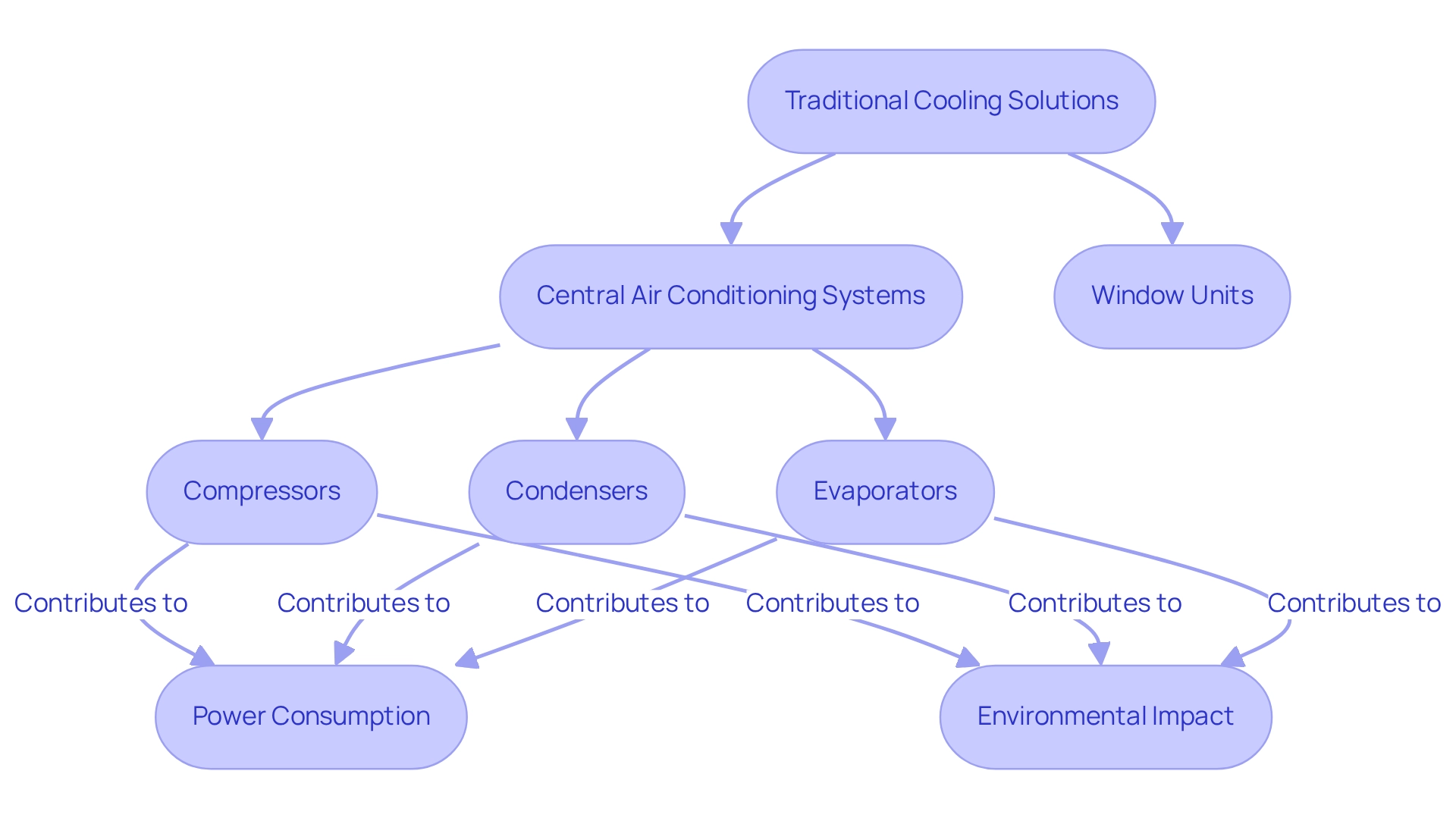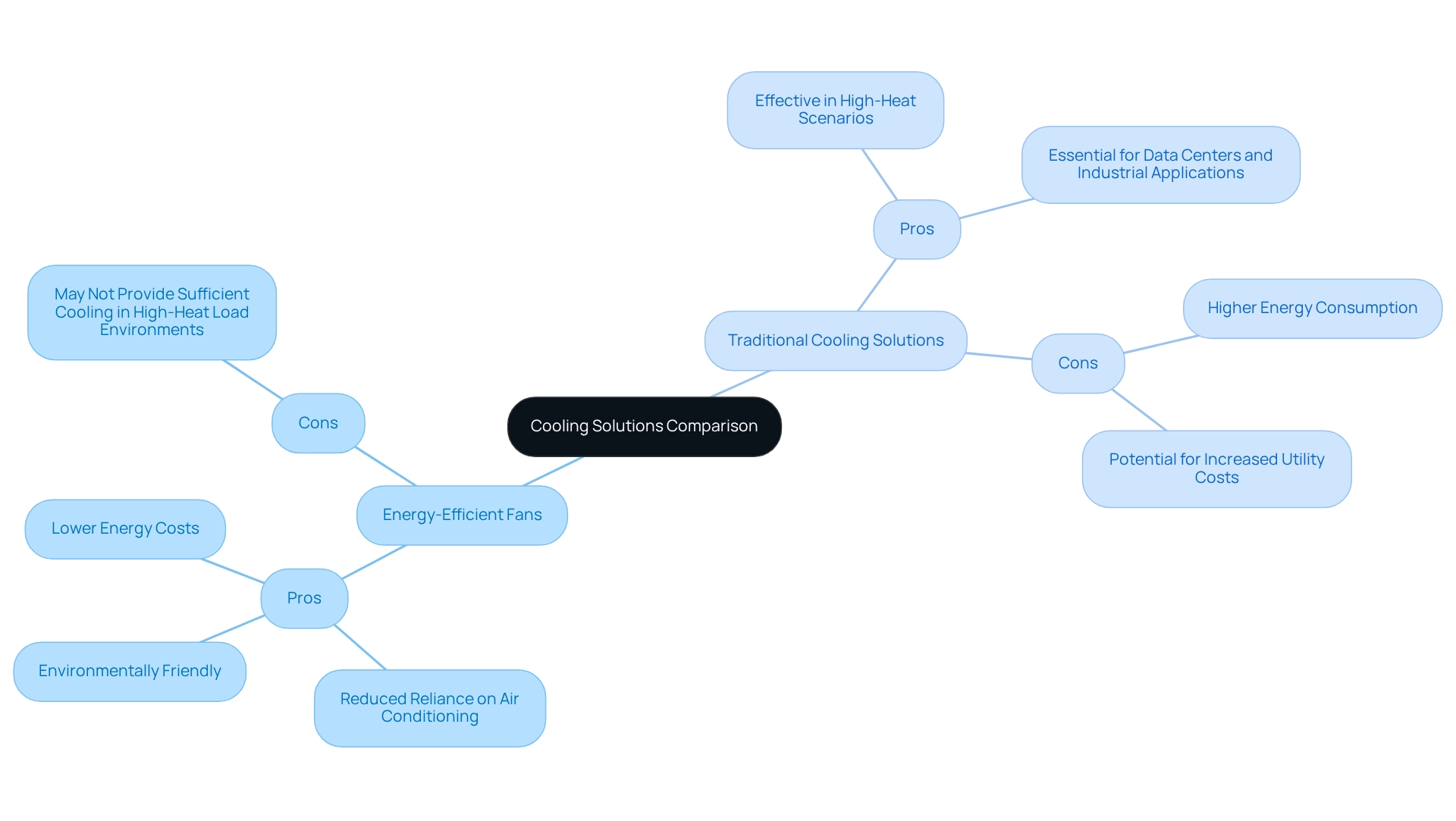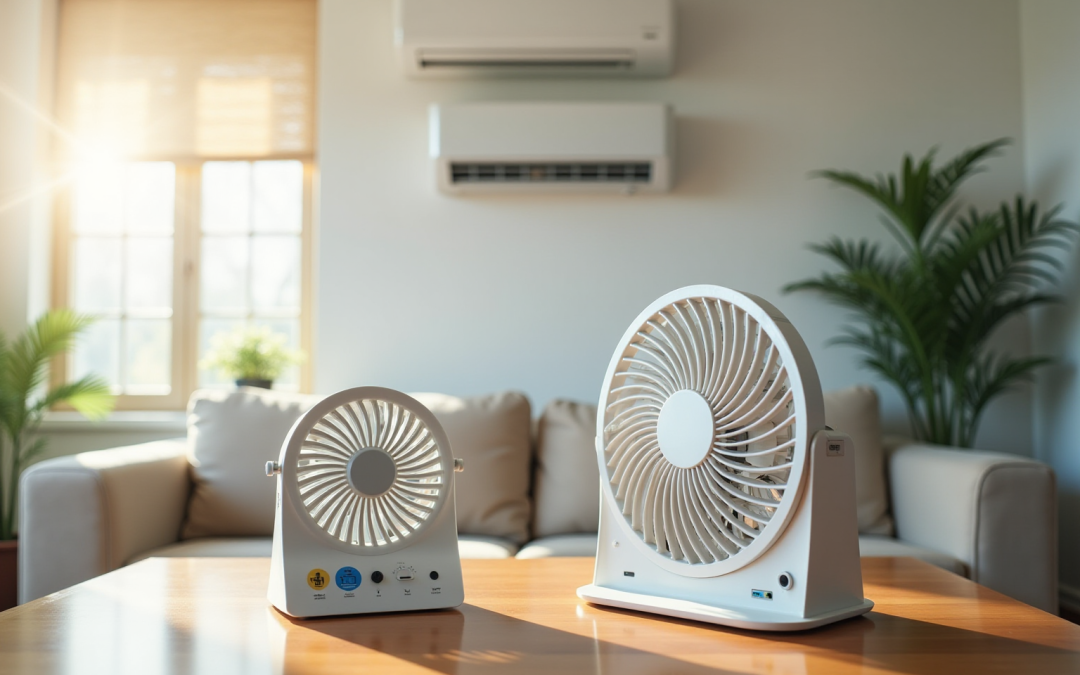Overview
Energy-efficient fans significantly outperform traditional cooling solutions regarding energy consumption and cost-effectiveness, achieving up to a 70% reduction in power usage. This remarkable efficiency stems from the use of brushless DC motors, which optimize airflow while minimizing operational costs. In stark contrast, conventional air conditioning systems present high energy demands and a considerable environmental impact. By understanding these dynamics, stakeholders can make informed decisions that not only enhance efficiency but also contribute to sustainability.
Introduction
In a world increasingly focused on sustainability, the choice between energy-efficient fans and traditional cooling solutions has never been more critical. Energy-efficient fans, particularly those utilizing brushless DC motors, promise significant reductions in power consumption while delivering optimal airflow. This makes them a compelling alternative to conventional air conditioning systems.
As companies and consumers alike seek to minimize their environmental impact and operational costs, understanding the mechanics, benefits, and limitations of both cooling methods becomes essential.
This article delves into the intricacies of energy-efficient fans versus traditional cooling systems, exploring their applications, performance, and the shifting preferences in an era of heightened energy awareness.
Understanding Energy Efficient Fans and Traditional Cooling Solutions
Energy-efficient fans, especially those that utilize brushless DC (BLDC) motors, are engineered to optimize airflow while significantly reducing power consumption compared to traditional models that employ AC motors. Gagner-Toomey Associates, the world’s largest producer of standard and custom air-movers, offers an extensive range of , ranging from 15 to 280mm, and Centrifugal Blowers, sized from 15 to 225mm, all optimized for performance and efficiency across various applications, including electronics and automotive sectors. In contrast, conventional temperature regulation methods, such as air conditioning units and evaporative coolers, often depend on energy-intensive processes to achieve lower ambient temperatures. This distinction is crucial, as energy efficient fans not only lower electricity consumption but also result in reduced operational expenses and a diminished environmental footprint. Conversely, traditional methods for temperature control, while effective for rapid cooling, can lead to elevated utility bills and increased greenhouse gas emissions due to their reliance on fossil fuels and electricity sourced from non-renewable resources.
Recent statistics indicate that an energy efficient fan can achieve up to a 70% reduction in power usage compared to standard AC fans, as highlighted in the case study titled ‘EC Fans Make Cooling More Efficient and Sustainable.’ This positions them as a sustainable choice for various applications, including electronics cooling. The benefits of extend beyond power savings; they also offer quieter operation and longer lifespans due to their brushless design. Real-world applications demonstrate the effectiveness of these energy efficient fans in sectors such as cryptocurrency mining, where energy efficiency is paramount, as underscored in the same case study.
Expert opinions reinforce the growing preference for energy-efficient devices over traditional temperature control methods, with numerous engineers noting their superior performance and cost-effectiveness. Randall Scasny, a senior community content specialist for Avnet’s element14 Community, asserts that “the shift towards energy-efficient technologies is not just a trend; it’s a necessity for sustainable development in the electronics industry.” As the demand for sustainable technologies escalates, the transition to energy-efficient fan systems becomes increasingly evident, highlighting the importance of embracing innovative solutions within the electronics sector. Furthermore, many models from Gagner-Toomey Associates incorporate IP protection and low noise optimization features, further enhancing their appeal across diverse applications.
How Energy Efficient Fans Operate
Energy-saving ventilators leverage advanced motor technologies, particularly Brushless DC (BLDC) motors, engineered to minimize power loss during operation. These motors utilize electronic controllers that finely adjust speed and torque, enabling precise airflow management. As a result, power consumption can be reduced by up to 70% compared to conventional AC motors. The development of efficient motors is anticipated to save gigawatts of electricity across various sectors, with significant potential savings in India.
Furthermore, many energy-saving devices feature variable speed options and intelligent technology integration, allowing users to tailor performance to specific temperature requirements. This adaptability not only enhances comfort but also leads to substantial long-term cost savings. Engineers have noted that implementing BLDC motors in markedly boosts operational efficiency, making the energy efficient fan a prudent choice for energy-conscious applications.
For instance, a global textile manufacturer successfully decreased power costs and carbon emissions by adopting a biomass-fired boiler solution, illustrating the tangible benefits of resource-efficient technologies. Additionally, the integration of intelligent technology in temperature regulation systems facilitates enhanced monitoring and control, further optimizing energy consumption.
Mechanics of Traditional Cooling Solutions
Traditional temperature control solutions, including central air conditioning systems and window units, function by circulating refrigerant through a closed loop. This process effectively absorbs heat from indoor air and releases it outside, utilizing essential components such as compressors, condensers, and evaporators. However, these systems are notorious for their high power consumption, particularly during peak usage periods, which is why investing in an energy efficient fan can help reduce substantial electricity bills. For instance, average electricity expenses can surge considerably during summer months, with conventional air conditioning systems representing nearly 12% of total residential power consumption in the U.S.
Moreover, the environmental effects of these systems cannot be overlooked. Numerous conventional temperature regulation methods rely on refrigerants with high global warming potential (GWP), significantly contributing to climate change. Studies indicate that some refrigerants possess a GWP thousands of times greater than carbon dioxide, underscoring the urgency for a transition towards more sustainable options. As consumers and engineers alike search for solutions that minimize power usage and environmental damage, it is significant to note that 34% of consumers surveyed report postponing vital home services due to economic pressure, highlighting the financial implications of utility expenses linked to traditional climate control options.
Routine upkeep, such as changing air filters, is crucial for enhancing HVAC performance and minimizing power consumption. can reduce by 5 to 15%, thereby improving both comfort and cost-effectiveness. As the demand for energy-efficient fans in refrigeration solutions escalates, understanding the mechanics and consequences of conventional systems becomes increasingly vital. Professional evaluations from HVAC specialists affirm that proactive maintenance not only enhances efficiency but also prolongs the lifespan of climate control systems, further reducing power usage.

Comparative Benefits and Drawbacks of Each Solution
In the comparison of energy-saving devices and traditional cooling solutions, several critical factors emerge. An energy efficient fan is recognized for its lower operational costs and decreased power usage, making it an appealing choice for numerous users. Research indicates that increasing the setpoint temperature from 24 °C to 26.5 °C can significantly lower usage intensity, resulting in a 32% decrease in consumption, amounting to savings of roughly 11.6 kWh/m·yr. This decrease is primarily linked to reduced chiller power consumption, emphasizing the potential for substantial savings in temperate climates where intense refrigeration is not necessary.
However, the efficiency of energy-saving devices can diminish in extremely high temperatures or expansive areas, where conventional systems excel due to their rapid and robust temperature reduction capabilities. These systems are indispensable in extreme heat conditions, as they can swiftly lower temperatures to comfortable levels. Nevertheless, conventional solutions entail and maintenance needs; for instance, the operational expenses related to refrigerants can significantly influence total expenditures.
The decision between energy-efficient fans and conventional temperature control methods ultimately hinges on specific use scenarios, climate factors, and personal preferences. In settings where residents favor somewhat warmer temperatures—29% of participants in a recent study indicated this—using an energy efficient fan can enhance comfort while reducing energy use. Conversely, in situations necessitating prompt and effective temperature regulation, conventional systems may be more suitable despite their increased operational expenses. As Michael G. Kent observed, “Occupants primarily depended on ceiling devices when the setpoint temperature was increased,” underscoring the importance of such equipment in enhancing comfort under particular circumstances.
In summary, while energy-efficient devices present a compelling case for cost savings and environmental advantages, conventional temperature control solutions remain crucial for their effectiveness in extreme conditions. Understanding these dynamics is essential for making informed decisions tailored to specific needs.
Suitability of Energy Efficient Fans vs. Traditional Solutions for Different Applications
Energy-efficient fans are particularly well-suited for home environments, small workplaces, and any setting that prioritizes energy conservation. They excel in applications that require effective air circulation without causing significant temperature drops, making them ideal for areas where comfort is paramount without the necessity for intense refrigeration. For instance, in residential settings, the use of an energy efficient fan can enhance airflow, thereby reducing reliance on air conditioning and lowering utility costs. This is exemplified by Nexstar Homes’ initiative to promote energy-saving materials that improve comfort and reduce expenses. In contrast, conventional temperature regulation solutions are essential for commercial structures, data centers, and industrial environments where rapid temperature control is critical to protect sensitive equipment and maintain operational efficiency. In high-heat load scenarios, such as server rooms, conventional systems are often indispensable to ensure optimal performance. Engineers emphasize that in data centers, where equipment generates substantial heat, conventional temperature regulation techniques are vital for preserving system integrity and performance metrics. Notably, models that account for 75 percent of all GFB shipments will require redesigning within the next five years, underscoring the urgent need for implementing resource-efficient solutions in the sector.
Ultimately, the choice between and conventional temperature regulation options should be guided by various factors, including the dimensions of the area, local weather conditions, utility expenses, and specific temperature control requirements. For example, while an energy efficient fan can effectively circulate air in residential and small office settings, traditional systems may be necessary in larger commercial spaces to manage heat loads effectively. The Department of Energy highlights that the financial advantages from reduced emissions of CO, CH, NO, and SO are considerable when evaluating energy-efficient options. Understanding these distinctions is crucial for making informed decisions that align with both performance needs and energy conservation objectives.
Pros and Cons:
-
Energy-Efficient Fans:
- Pros: Lower energy costs, reduced reliance on air conditioning, environmentally friendly.
- Cons: May not provide sufficient cooling in high-heat load environments.
-
Traditional Cooling Solutions:
- Pros: Effective in high-heat scenarios, essential for data centers and industrial applications.
- Cons: Higher energy consumption, potential for increased utility costs.

Conclusion
The exploration of energy-efficient fans versus traditional cooling solutions reveals a clear shift towards sustainability and cost-effectiveness in cooling technologies. Energy-efficient fans, particularly those utilizing brushless DC motors, stand out for their significant reduction in energy consumption—up to 70% compared to traditional AC motors. This substantial decrease not only translates into lower electricity bills but also results in a smaller environmental footprint, making them an attractive option for both residential and commercial applications.
While traditional cooling systems are indispensable in high-heat environments and offer rapid cooling capabilities, they come with higher operational costs and a greater environmental impact due to their reliance on energy-intensive processes and refrigerants with high global warming potential. Understanding the mechanics and limitations of each system is crucial for making informed decisions that align with specific needs and energy conservation goals.
Ultimately, the choice between energy-efficient fans and traditional cooling solutions should be guided by an awareness of application requirements, climate conditions, and energy costs. As the demand for sustainable technologies continues to grow, embracing energy-efficient alternatives not only supports individual and organizational goals but also contributes to a broader commitment to environmental stewardship. The future of cooling solutions lies in a balanced approach that recognizes the strengths of both technologies while prioritizing efficiency and sustainability.
Frequently Asked Questions
What are energy-efficient fans and how do they differ from traditional fans?
Energy-efficient fans, particularly those with brushless DC (BLDC) motors, are designed to optimize airflow while significantly reducing power consumption compared to traditional AC motor fans. They achieve up to a 70% reduction in power usage, making them a more sustainable option.
What applications are energy-efficient fans suited for?
Energy-efficient fans are optimized for various applications, including electronics cooling and the automotive sector. They are particularly beneficial in scenarios where energy efficiency is crucial, such as cryptocurrency mining.
How do energy-efficient fans impact operational expenses and the environment?
By lowering electricity consumption, energy-efficient fans result in reduced operational expenses and a smaller environmental footprint. In contrast, traditional cooling methods can lead to higher utility bills and increased greenhouse gas emissions.
What advantages do brushless DC motors provide in energy-efficient fans?
Brushless DC motors offer quieter operation, longer lifespans, and improved power savings compared to traditional motors. They also allow for precise airflow management through electronic controllers that adjust speed and torque.
What expert opinions support the use of energy-efficient fans?
Experts, including engineers, emphasize the superior performance and cost-effectiveness of energy-efficient devices over traditional temperature control methods. They highlight the necessity of adopting these technologies for sustainable development in the electronics industry.
How do intelligent technology and variable speed options enhance energy-efficient fans?
Many energy-saving fans feature variable speed options and intelligent technology integration, allowing users to customize performance based on specific temperature requirements, leading to enhanced comfort and long-term cost savings.
Can you provide an example of the benefits of adopting energy-efficient technologies?
A global textile manufacturer demonstrated the benefits of resource-efficient technologies by decreasing power costs and carbon emissions through the adoption of a biomass-fired boiler solution, showcasing the tangible impacts of energy-efficient systems.

